CORDOBA – Córdoba’s patios are open again for a new edition of the annual ‘Los Patios de Córdoba’ festival, which lasts until 15 May. A visit to the patios, whose whitewashed walls have witnessed the passing of the years and the changes of the last century, is more than worthwhile.
Numerous curiosities, anecdotes, and experiences have been preserved about these flowery courtyards. In his book ‘Córdoba es Patio’, the journalist Francisco Solano, from Córdoba, shares some of these unique stories about Córdoba´s patios.
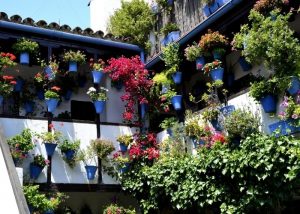 The oldest of Córdoba´s patios is 2,000 years old
The oldest of Córdoba´s patios is 2,000 years old
The origins of today’s courtyards go back centuries to the Roman civilisation. According to the author, the oldest surviving courtyard in Cordoba is located under the dining room of the Hotel Hospes Palacio del Bailio and is 2,000 years old.
Another visible Roman courtyard is located at the intersection of El Algarrobo and Los Chopos streets (Huerta de San Rafael). ‘It belonged to a villa excavated here, where the archaeological traces of a central fountain, mosaic, the bases of twelve columns and a cellar can be seen’, writes Solano.
Weddings and spiral staircases
In the first decades of the 20th century, the people’s courtyards were the centre of life for the families living there. This distinguished them from the aristocratic families, who had the luxury of a garden.
In the past, the people organised family celebrations in these courtyards, such as ‘the wedding, the baptism, the return of the soldier on a field trip’, according to ‘Córdoba es Patio’, based on an article by Ricardo de Montis written in 1911. On some nights, usually Saturdays, the festivities lasted until dawn, between jasmine, rose bushes, and climbing plants. Carnations, climbing geraniums, and geraniums grow most in the courtyards of Cordoba; however, there seem to be some 180 flowers in total.
Interesting read: Córdoba´s Moorish history
First competition in 1921
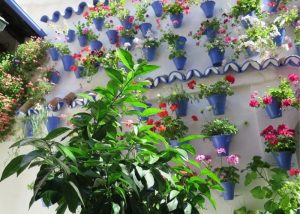 In 1921, the mayor, Francisco Fernández de Mesa, announced the first competition for courtyards, balconies, and shop windows. There were three prizes, of 100, 75 and 50 pesetas, which were awarded to the only three participants. The winner was Calle Empedrada, 8, in the Santa Marina district. Today it is Empedrada, 10, and is still occupied by the descendants of the owner who won the first competition, Francisco Velasco.
In 1921, the mayor, Francisco Fernández de Mesa, announced the first competition for courtyards, balconies, and shop windows. There were three prizes, of 100, 75 and 50 pesetas, which were awarded to the only three participants. The winner was Calle Empedrada, 8, in the Santa Marina district. Today it is Empedrada, 10, and is still occupied by the descendants of the owner who won the first competition, Francisco Velasco.
The crosses in Córdoba´s patios
Another fact about the patios of Cordoba relates to the crosses; in 1925 the Town Hall organised the first competition for the crosses placed in the patios. This was won by the cross placed in Ocaña, 1. The prize was 350 pesetas, an economic donation that was to be increased. That year there were 20, and the following year the number had doubled.
This short-lived initiative lasted only five years: it was last held in 1929, coinciding with the visit of the dictator Miguel Primo de Rivera to the city.
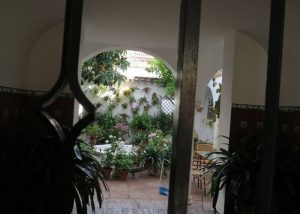 Twelve-year pause
Twelve-year pause
Due to the lack of interest in the first contest in 1921, the municipal council decided not to organise the contest again until 1933. However, the civil war put a spanner in the works and the competition was not revived until 1944. This time, under the tenure of Antonio Luna Fernández (1944-1951).
Twenty competitions have been held continuously in the 21st century. This was with the exception of the year 2020 when the pandemic forced a suspension in the month of May. However, the opening, without a contest, took place in October of that year.
In the first competitions, it was the patrons themselves who nominated the candidates, but from 1967 the competition was opened to all women from Cordoba. The prize consisted of a ‘trahe de faralae’ – a flamenco-like dress with strips – a tiara and a brooch, and in 1967 it also included 20,000 pesetas and a weekend on the Costa del Sol.
Into oblivion
With the passage of time, many of Cordoba’s courtyards have become forgotten and dilapidated. This is the case of Badanas 15, which has won ten first prizes in the 25 years it has been in existence. Furthermore, it was a real courtyard for residents – as many as 19 families lived there – and contained some 2,000 flower pots.
However, today, that patio is closed and deserted. Years ago, neighbour Bodegas Campos tried to buy the patio, but there was no agreement on the price.
The house at 12 Montero Street, in the heart of the San Agustín district, had three courtyards. They were crowned in 1965 and 1972. The memory of Albucasis, 6, another lost courtyard, also remains on paper and in the minds of some.
The patios in literature
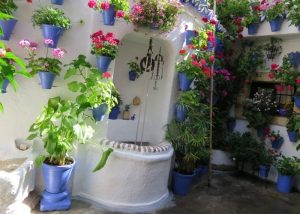 The patios of Cordoba have served as a setting for many literary works. One of the first to be mentioned is Pío Baroja’s ‘La feria de los discretos’. Azorín, a contemporary of Baroja, also dwelt on the festive customs of Córdoba. Cordoba does not have the subtle atmosphere of lust that one breathes in Seville; there is a tone of severity, of asceticism, that prevails in the houses’, writes the author of ‘La voluntad’. And he adds: ‘Cordoba is a small courtyard paved with small stones, a whitewashed wall with a blue plinth and the smell of burnt olive trees in the air’.
The patios of Cordoba have served as a setting for many literary works. One of the first to be mentioned is Pío Baroja’s ‘La feria de los discretos’. Azorín, a contemporary of Baroja, also dwelt on the festive customs of Córdoba. Cordoba does not have the subtle atmosphere of lust that one breathes in Seville; there is a tone of severity, of asceticism, that prevails in the houses’, writes the author of ‘La voluntad’. And he adds: ‘Cordoba is a small courtyard paved with small stones, a whitewashed wall with a blue plinth and the smell of burnt olive trees in the air’.
Juan Valera describes Córdoba´s patios in some of his novels, where part of the story takes place. In ‘Pepita Jiménez’, for instance, we read that ‘each house has its own door. The main entrance leads to the cobbled courtyard with its columns, the halls, and other stately rooms…’ ‘Las ilusiones del Doctor Faustino’ and ‘Juanita la Larga’ are no strangers to this kind of passage.
In poetry
Later, the greatest exponent of Modernism, Rubén Darío, would report on his time in Cordoba. The Nicaraguan poet remarks in ‘Tierras solares’; ‘Neither in Granada, nor in Seville, nor in Málaga did I find that atmosphere of antiquity of this illuminated capital. And in the narrowness and solitude of its streets, the ancient latticework, the window that fosters the love of romance, the mysterious courtyards that one can glimpse’.
Poets, too, mostly local but also some from other provinces, have been inspired by the patios. From Cadiz, Fernando Quiñones sent the following verses to Pablo García Baena.
Today I think of you at the edge of a street in Córdoba / The river sings. What a sun. A chance of orange blossom ventures / through the streets, through the poor walls and tiles we love, / through the taverns where time / drinks with us, through the courtyards.
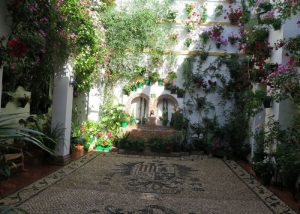 Price for a ruined courtyard
Price for a ruined courtyard
One of the most curious cases of the competition took place in 1979, ‘when the first prize went to the courtyard of Calle Polacas 3, a house that had been declared a ruin by the town hall itself, the organiser of the competition, a real paradox’.
Of the twelve families that once lived in the house, only two remain (nine people in total). The award came as a blessing to the residents. ‘It is a fact that the courtyard has made the residents so attached to the traditional quality of life that it has given them the strength and courage not to worry’, despite the poor condition of the building.
Read more:


